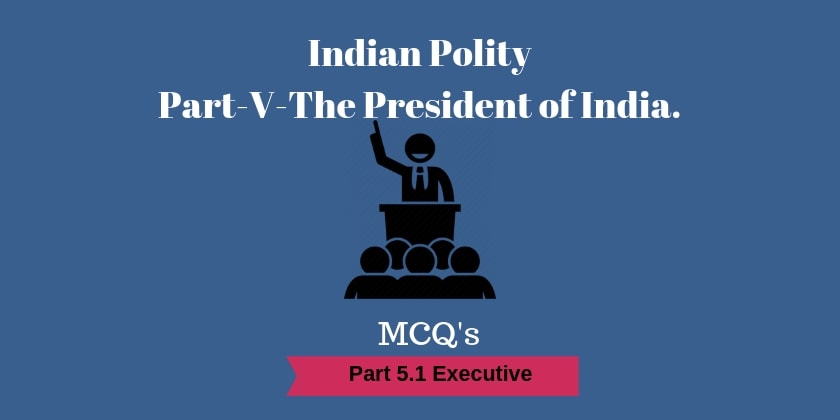Indian Polity Part V: The President Of India
Part V The Union Art. 52 to 151
The President of India comes under Part V The Union. Here we solve all the multiple type questions from chapter first executive’s The President of India.
Part – V: The President Of India
The President of India is the first citizen of India and he is the head of the Indian State. The President is the supposed to act as the symbol of the unity, integrity, and solidarity of the nation.
Under part V The Union Article 52 to 151.
1. Article 52 The President of India
2. Article 53 Executive power of the Union
3. Article 54 Election of President
4. Article 55 Manner of election of President
5. Article 56 Term of office of President
6. Article 57 Eligibility for re-election
7. Article 58 Qualifications for election as President
8. Article 59 Conditions of President’s office
9. Article 60 Oath or affirmation by the President
10 Article 61 Procedure for impeachment of the President
11. Article 62 Time of holding an election to fill the vacancy in the office of president and the term of office or person elected to fill the casual vacancy
President’s Powers and Duties:
In Indian constitution, the president has 6 power and duties.
- Executive powers (Article: 74-77)
- Legislative Powers (Article: 78-86)
- President’s veto power (Article: 111)
- Financial powers (Article: 112,117,115,280)
- Judicial powers (Article: 72,143)
- Diplomatic powers
- Military powers (Article: 53)
- Emergency Powers (Article: 352,356,360)
1. Which Article of the Indian Constitution says that there shall be a President of India?
A. 61
B. 62
C. 52
D. 74
[toggle] Answer – C [/toggle]
2. Who participates in the Presidential election?
A. Elected members of both Houses of Parliament
B. Elected and nominated members of the State Legislative Assembly
C. Members of all Union Territories
D. All of the above
[toggle] Answer – A [/toggle]
3. What qualifications should be to become a President?
A. 35 years of age
B. He should be eligible to be elected as a member of Rajya Sabha.
C. Must be an Indian citizen
D. Only a and c
[toggle] Answer – D
Explanation: To become President of India, the candidate must be 35 years old, must be an Indian citizen and should be eligible to be elected as a member of Lok Sabha.[/toggle]
4. The executive actions of the government are carried out under whose name?
A. Cabinet
B. Prime Minister
C. President
D. Both B. and C.
[toggle] Answer – C [/toggle]
5. The President may resign by writing addressing to
A. Prime Minister
B. Chief Justice of India
C. Lok Sabha Speaker
D. Vice-President
[toggle] Answer – D[/toggle]
5. Which of the following statements is wrong?
A.. Elected and nominated members of the State Legislative Assembly participate in the presidential election.
B. The Union Executive includes the President, Vice President, Prime Minister, Attorney General of India
C. Impeachment may be initiated against the President for ‘breach of the constitution’
D. Article 56 envisages the tenure of the President
[toggle] Answer – A
Explanation: Only elected members of the State Legislative Assembly participate in the presidential election, nominated members do not participate.[/toggle]
6. Which of the following is not matched?
A.. Article 54 – Presidential election
B. Article 55 – manner of presidential election
C. Article 60 – Procedure for impeachment of the President
D. Article 123 – Power of the President to promulgate the ordinance
[toggle] Answer – C
Article 60 is related to oath and affirmation of the President.[/toggle]
7. Who among the following are appointed by the President of India
A. Chairman, Finance Commission
B. deputy chairman, Planning commission
C. Chief Minister of Union Territory
D. Both A & B
[toggle] Answer – D[/toggle]
8. Who has the power to grant pardons or suspend, remit or commute the sentence of any convicted person?
A. Vice-President
B. Prime Minister
C. President
D. Home Minister
[toggle] Answer – C [/toggle]
9. Impeachment (removal) of the president is mentioned in which article?
A.Article 55
B.Article 57
C.Article 59
D.Article 61
[toggle] Answer – D[/toggle]
10. To initiate a procedure for the removal of the President, how many members are required in either house of Parliament?
A.1/2nd members
B.1/3 rd members
C.1/4th members
D.1/5th members
[toggle] Answer – C [/toggle]

